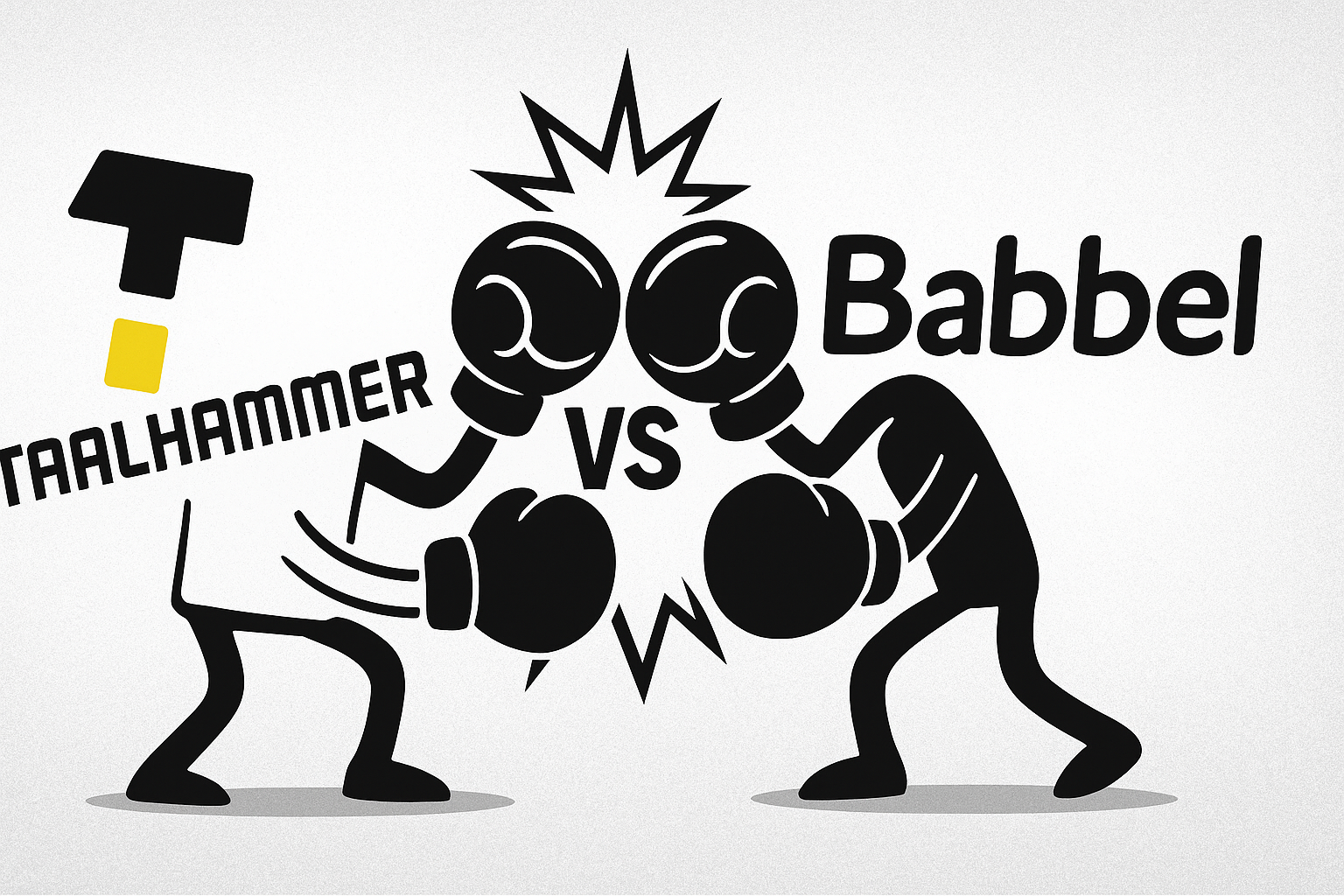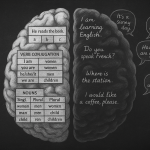Choosing a language learning app in 2025 isn’t easy. With dozens of options on the market, many learners ask the same question: “Which is better: Taalhammer or Babbel?” Both apps are popular, both promise faster progress, and both claim to be built on solid learning methods – but they serve different kinds of learners.
If you’re looking for:
- Structured lessons and dialogues → Babbel has a reputation for being exactly what gives you structure.
- Science-based spaced repetition and sentence training → Taalhammer is designed with that exact goal in mind.
So, which language learning app really helps you learn better, and for whom?
This article will break down Taalhammer vs Babbel in detail – their strengths, weaknesses, and which learners they suit best. By the end, you’ll have a clear verdict on which language learning app is better and why.
- What to Look for in a Language Learning App (Grammar, Speaking, CEFR, Motivation)
- Taalhammer: Strengths, Weaknesses, and Who It’s For
- Babbel: Strengths, Weaknesses, and Who It’s For
- Which Language Learning App Is Better for Whom?
- Verdict: Which Is Better – Taalhammer or Babbel?
- FAQs About Taalhammer vs Babbel
What to Look for in a Language Learning App (Grammar, Speaking, CEFR, Motivation)
Before diving into Taalhammer and Babbel, it helps to define what actually makes a good language learning app. Not all apps aim for the same outcomes. Some focus on casual practice, others on long-term fluency or exam readiness.
When evaluating apps, most learners care about four big factors:
Depth of Grammar and Vocabulary
- Does the app just teach words, or does it train grammar patterns in real sentences?
- Is the vocabulary practical, or does it lean on quirky examples that won’t transfer to real life?
Speaking and Listening Practice
- Can the app prepare you for real conversations?
- Does it include native-speaker audio and pronunciation training?
Progress Tracking and CEFR Alignment
- Does the app show you where you stand (A1, A2, B1, etc.)?
- Are lessons structured around official standards like CEFR, which are used in exams and certificates?
Motivation and Retention
- Is the app designed to keep you engaged long-term?
- Does it use science-backed methods like spaced repetition to make sure you don’t forget what you’ve learned?
Taalhammer: Strengths, Weaknesses, and Who It’s For
Taalhammer positions itself as a science-based language learning app designed for learners who want more than just casual play. Its method combines sentence-based input with spaced repetition (SRS), ensuring that what you learn sticks for the long term. Unlike gamified apps, Taalhammer is closer to a digital personal tutor that tracks your knowledge, adapts, and pushes you toward fluency.
Strengths of Taalhammer
- Sentence-first approach: You learn real, usable sentences instead of isolated words. This helps transfer knowledge directly to speaking and writing.
- Spaced repetition with adaptive recall: The app uses cognitive science to reintroduce words and structures right before you forget them, strengthening memory.
- Native-speaker audio + IPA transcription: Perfect for learners who want to improve pronunciation and listening skills.
- CEFR-aligned collections: You can follow structured paths (A1–C1) or import your own material to personalize learning.
- Ideal for serious learners: Particularly strong for those preparing for exams, or who want deep grammar and vocabulary retention.
Weaknesses of Taalhammer
- Less gamification: no streak mascots or flashy rewards, which may feel less fun for casual learners.
- Designed more for depth than light entertainment – those seeking playful daily practice might prefer a different language learning app.
Taalhammer at a Glance
| Feature | How Taalhammer Handles It |
|---|---|
| Learning Method | Sentence-based SRS with adaptive recall |
| Grammar | Integrated in context, reinforced through exposure |
| Pronunciation | Native-speaker audio + IPA transcription |
| Progress Tracking | CEFR levels, retention rates, time-to-fluency estimates |
| Best For | Serious learners, exam prep, multilingual learners |
Who Should Choose Taalhammer?
- Learners who want fast progress toward fluency, not just casual exposure.
- Students preparing for language certificates (B2, C1).
- Polyglots and advanced learners who want to import their own materials and personalize study.
- Anyone who values science-backed retention methods over gamified features.
Babbel: Strengths, Weaknesses, and Who It’s For
Babbel is one of the most recognizable names in the language learning app market. It offers CEFR-based courses (A1–B2) designed by professional linguists, with lessons built around short dialogues and grammar explanations. Its approach is structured and easy to follow, but it is also more traditional and less adaptive compared to newer tools like Taalhammer.
Strengths of Babbel
- Structured courses: Clear linear progression through CEFR levels (A1–B2), making it good for learners who like order and step-by-step guidance.
- Dialogues for everyday use: Lessons are based on common situations such as shopping, travel, or small talk. Very basic selection.
- Explicit grammar tips: Explanations are concise and accessible, which helps learners understand rules quickly.
- Professional design: Courses are put together by linguists and teachers, ensuring accuracy and quality.
Weaknesses of Babbel
- Limited adaptivity: The course structure is linear, with little personalization. Learners cannot import their own material or tailor content to their goals.
- Shallow retention system: Reviews are available but not powered by advanced spaced repetition like Taalhammer. This means knowledge may fade faster.
- Capped at B2: No content beyond upper-intermediate level, making it less suitable for advanced learners or exam candidates at C1/C2.
- Speaking practice is limited: Speech recognition exists, but feedback is basic compared to practicing with authentic sentence recall.
- Subscription-based with less flexibility: You pay for access to courses, but you cannot fully customize learning paths.
Babbel at a Glance
| Feature | How Babbel Handles It |
|---|---|
| Learning Method | Linear CEFR lessons with dialogues |
| Grammar | Explicit explanations, simplified for ease |
| Pronunciation | Speech recognition; basic feedback |
| Progress Tracking | Lesson completion, simple reviews |
| Best For | Adults who like structured, everyday communication |
Who Should Choose Babbel?
- Learners who prefer guided, classroom-style lessons in a digital format.
- Adults who want to handle basic daily communication for travel or work.
- Beginners to intermediate learners who value simple, structured courses over flexibility.
Where Babbel Falls Short Compared to Taalhammer
- Retention: Without advanced spaced repetition, progress can be slower and more forgettable.
- Adaptivity: Content is fixed, while Taalhammer allows importing any material you want.
- Advanced Learning: Stops at B2, while Taalhammer supports higher-level learners.
- Exam Prep: Babbel isn’t designed for certificate readiness, while Taalhammer has CEFR collections built for it.
Which Language Learning App Is Better for Whom?
The real question most learners have is not just “What does each language learning app do?” but “Which one is right for me?”. To answer this, let’s look at different learner profiles.
Taalhammer vs Babbel: Which Language Learning App Is Better for Beginners and Adults?
For beginners, Babbel’s linear courses can feel reassuring, with short dialogues and clear grammar tips. Adults who prefer a structured, classroom-like progression may find Babbel a comfortable entry point. However, Taalhammer also serves beginners well thanks to ready-made CEFR collections and adaptive repetition, which ensures nothing gets forgotten. For adults with limited study time who want their learning to stick, Taalhammer’s approach is more efficient and sustainable.
| Learner Type | Taalhammer | Babbel |
|---|---|---|
| Beginners | CEFR-based collections from A1; adaptive spaced repetition ensures nothing is forgotten | Linear lessons with dialogues and grammar tips; simple to follow |
| Adults | Flexible, efficient study with personalized collections; better for limited study time | Structured, classroom-like progression; clear but less adaptive |
Want a broader comparison? See: Best Language Learning App for Beginners: Full Comparison of 12 Tools and Best Language Learning Apps for Adults in 2025.
Taalhammer vs Babbel: Which Language Learning App Helps Most with Speaking and Grammar?
Babbel provides useful starter dialogues and simple grammar explanations, but speaking practice is limited to basic speech recognition. Taalhammer, in contrast, trains grammar directly through sentences and reinforces it with spaced repetition. Because every sentence comes with native audio and phonetic transcription, learners practice real pronunciation and recall whole phrases, making it easier to speak naturally. For grammar depth and spoken fluency, Taalhammer is clearly the stronger choice.
| Focus Area | Taalhammer | Babbel |
|---|---|---|
| Speaking | Native-speaker audio + IPA; recall of full phrases builds natural fluency | Basic speech recognition; limited feedback beyond pronunciation check |
| Grammar | Learned in full sentences, reinforced by adaptive repetition | Short, simplified explanations; useful but less in-depth |
Struggling to speak confidently? See how different apps help in Which Language Learning App Helps You Overcome Fear of Speaking? Taalhammer vs 5 Top Alternatives.
Taalhammer vs Babbel: Which Language Learning App Is More Effective for Exam Preparation and Serious Learners?
This is where the gap between the two apps is most visible. Babbel’s content stops at B2 and does not simulate exam-style tasks. It can help build a foundation but will not take you to certificate readiness. Taalhammer, on the other hand, provides collections from A1 to C2, with countless topics and daily updates, making it ideal for learners who need structured CEFR preparation. Serious learners benefit from detailed retention tracking, adaptive review, and the ability to import their own exam materials. For anyone aiming at official certificates or higher-level mastery, Taalhammer is the clear winner.
| Focus Area | Taalhammer | Babbel |
|---|---|---|
| Exam Readiness | CEFR collections from A1 to C2; covers certificate-level tasks; adaptive review for mastery | Stops at B2; no exam-style tasks or higher-level preparation |
| Serious Learners | Retention tracking, customizable collections, ability to import personal study material | Fixed courses, limited personalization, less suited for advanced goals |
Want to pass language exams? Here’s a comparison: Taalhammer vs Duolingo, Busuu & others — Best Language Learning App for Certificates in 2025.
Verdict: Which Is Better – Taalhammer or Babbel?
So, which is better: Taalhammer or Babbel? The answer depends on what kind of learner you are, but the balance tilts strongly toward Taalhammer for anyone who takes language learning seriously.
Babbel offers a structured, familiar experience with short lessons and dialogues. It is a good fit for adults who want to cover everyday communication quickly and prefer a step-by-step course. But its limitations are clear: content stops at B2, retention is shallow, and personalization is minimal.
Taalhammer, by contrast, is built for long-term success. With 75 languages, countless collections from A1 to C2, and new material added daily, it adapts to every learner profile – from beginners to advanced, from casual learners to exam candidates. Its sentence-based method and adaptive spaced repetition ensure that what you learn today will still be accessible tomorrow, next month, and even next year.
For learners who want fluency, certificate readiness, and measurable results, Taalhammer is the better choice. Babbel works for casual users, but Taalhammer is the language learning app that truly delivers on the promise of mastering a language.
FAQs About Taalhammer vs Babbel
Is Babbel enough to become fluent or is Taalhammer better?
Babbel can help you build a solid foundation for everyday conversations, but it is not designed to take you beyond B2. Taalhammer goes further, with collections from A1 to C2, adaptive review, and sentence-based learning that prepares you for real fluency.
Which language learning app is better for CEFR levels, Taalhammer vs Babbel?
Babbel covers A1 to B2 with fixed courses. Taalhammer covers the full CEFR range, from A1 to C2, and adds new collections daily. This makes it the stronger choice for learners aiming at official certificates or advanced mastery.
Taalhammer vs Babbel: which language learning app gives long-term retention?
Babbel uses simple reviews but lacks advanced spaced repetition. Taalhammer is built on adaptive recall, ensuring you don’t forget what you’ve learned. This makes Taalhammer far more effective for long-term retention.
Taalhammer vs Babbel: which language learning app is worth paying for?
If your goal is casual conversation practice, Babbel may be enough, but if you want measurable progress, deep grammar knowledge, and lasting results, Taalhammer offers more value for your subscription.








